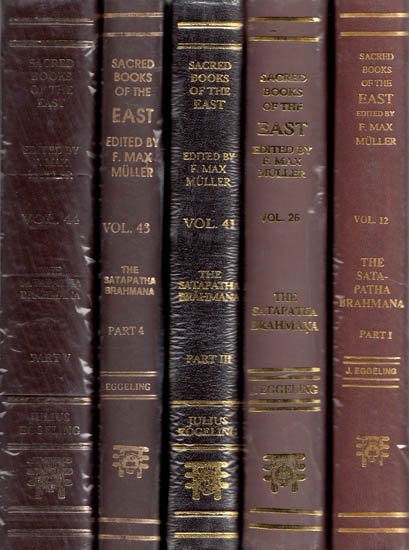Satapatha-brahmana
by Julius Eggeling | 1882 | 730,838 words | ISBN-13: 9788120801134
This is Satapatha Brahmana X.2.4 English translation of the Sanskrit text, including a glossary of technical terms. This book defines instructions on Vedic rituals and explains the legends behind them. The four Vedas are the highest authortity of the Hindu lifestyle revolving around four castes (viz., Brahmana, Ksatriya, Vaishya and Shudra). Satapatha (also, Śatapatha, shatapatha) translates to “hundred paths”. This page contains the text of the 4th brahmana of kanda X, adhyaya 2.
Kanda X, adhyaya 2, brahmana 4
[Sanskrit text for this chapter is available]
1. Prajāpati, indeed, is the year, and Agni is all objects of desire. This Prajāpati, the year, desired, 'May I build up for myself a body so as to contain[1] Agni, all objects of desire.' He constructed a body one hundred and one-fold; and in constructing a body one hundred and one-fold, he built up for himself a body so as to contain Agni, all objects of desire, and himself became all objects of desire; there was not one object of desire outside of him: whence they say, 'The year (includes) all objects of desire;' for, indeed, outside the year there is no object of desire whatever.
2. And in like manner does the Sacrificer now, by constructing a body (of the altar) one hundred and one-fold, build for himself a body so as to contain Agni, all objects of desire: he becomes all objects of desire, and not one object of (his) desire is outside of him.
3. Now this year is the same as yonder sun; and he is this one hundred and one-fold (Agni);--his rays are a hundredfold, and he himself who shines yonder, being the one hundred and first, is firmly established in this universe; and in like manner does the Sacrificer now establish himself in this universe by constructing for himself a body a hundred and one-fold.
4. And, indeed, the one hundred and one-fold passes into (becomes equal to) the sevenfold one; for yonder sun, whilst composed a hundred and one-fold, is established in the seven worlds of the gods, for, indeed, there are seven worlds of the gods,--the four quarters and these three worlds: these are the seven worlds of the gods, and in them that (sun) is established. And in like manner does the Sacrificer now establish himself in the seven worlds of the gods by constructing for himself a body a hundred and one-fold.
5. And, again, as to how the one hundred and one-fold (altar) passes into the sevenfold one:--yonder sun, composed of a hundred and one parts, is established in the seven seasons, in the seven stomas (hymn-forms), in the seven pṛṣṭha (-sāmans), in the seven metres, in the seven vital airs, and in the seven regions; and in like manner does the Sacrificer now establish himself in this universe (or, on everything here) by constructing for himself a body one hundred and one-fold.
6. And, again, as to how the one hundred and one-fold passes into the sevenfold one:--yonder sun, composed of a hundred and one parts, is established in the seven-syllabled Brahman, for the Brahman (holy writ or prayer) indeed consists of seven syllables,--'ṛk' is one syllable, 'yajuḥ' two, and 'sāma' two; and what other Brahman there is that is just the 'brahman' of two syllables--this seven-syllabled Brahman is the universe[2]: therein that (sun) is established; and in like manner does the Sacrificer now establish himself in the seven-syllabled Brahman by constructing for himself a body one hundred and one-fold.
7. Therefore, also, they lay down around (the altar) sets of seven (bricks) each time, and hence the one hundred and one-fold passes into the sevenfold one; and, indeed, the sevenfold one passes into the one hundred and one-fold.
8. Sevenfold, indeed, Prajāpati was created in the beginning. He saw this body composed of a hundred and one parts--fifty bricks in the Prāṇabhṛts[3], and fifty sacrificial formulas, that makes a hundred, and the 'settling' and sūdadohas-formula are the two one hundred and first--these two are one and the same, for when he has 'settled' (a brick), he pronounces the sūdadohas-formula over it: by means of this one hundred and one-fold body he gained that conquest and obtained that success; and in like manner does the Sacrificer, by means of this one hundred and one-fold body, gain that conquest and obtain that success. And thus, indeed, the sevenfold (altar) passes into the one hundred and one-fold: that which is a hundred and one-fold is sevenfold, and that which is sevenfold is a hundred and one-fold. So much as to the forms (of altars).
Footnotes and references:
[1]:
Literally, May I build for myself a body (self) with a view to (abhi) Agni; or, perhaps, 'He builds (a body) so as to become (Agni);' in which case 'abhi' of 'abhisaṃcinute' would have the same force as in 'abhisampadyate.' See, however, X, 2, 5, 9-12, where Sāyaṇa explains it by 'yo yaḥ kāmaḥ taṃ sarvam ātmānam abhilakṣya sampāditavān bhavati'--'He brings about (accomplishes) all that desire for his body.'
[2]:
Or, perhaps, 'all this (taken together) is the sevenfold Brahman.'
[3]:
In the first layer ten Prāṇabhṛt bricks were placed along the diagonals in each of the four corners of the body of the altar (or in the intermediate quarters), and as many round the centre.
